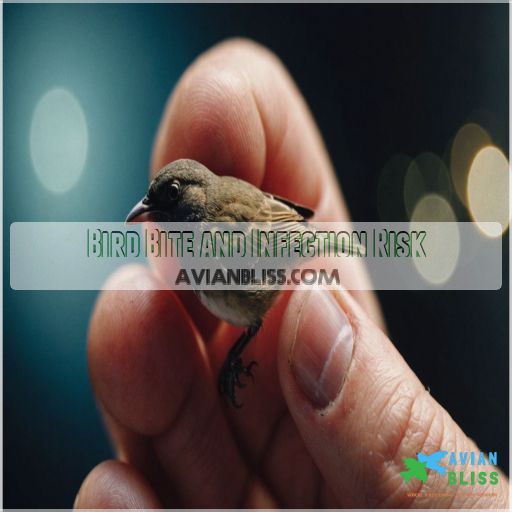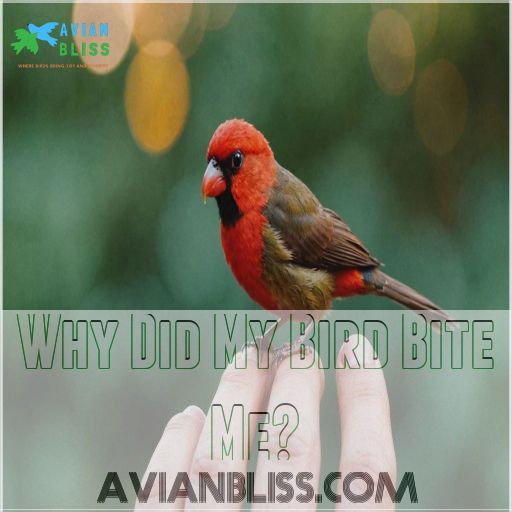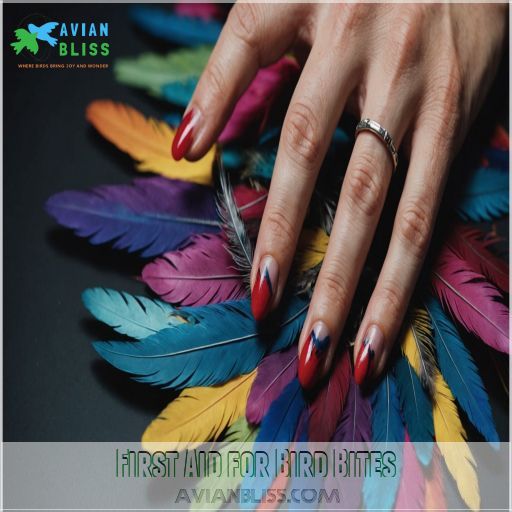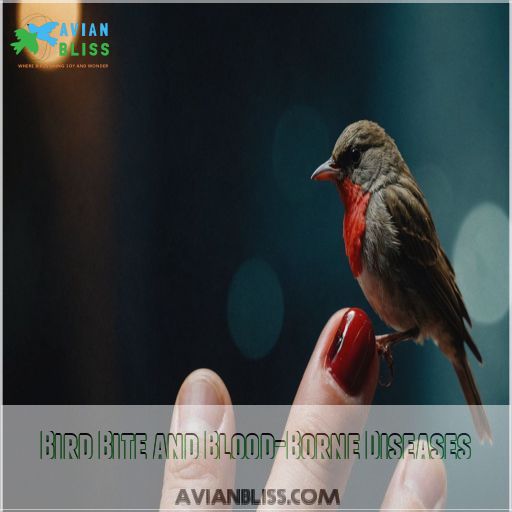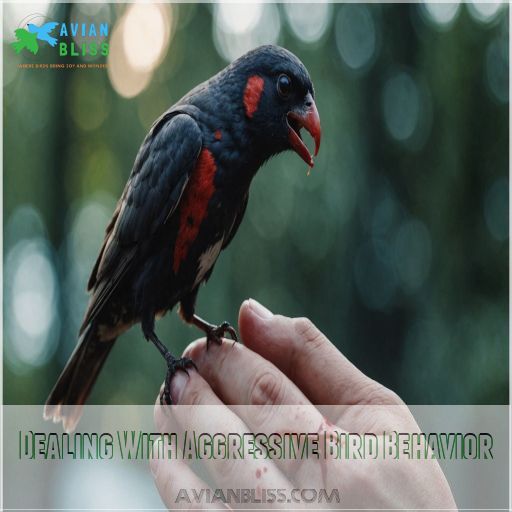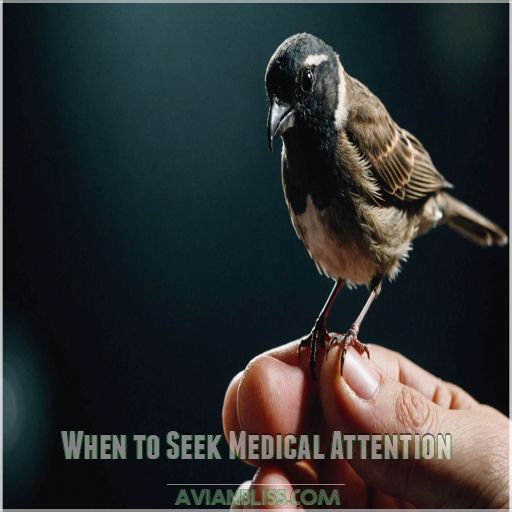This site is supported by our readers. We may earn a commission, at no cost to you, if you purchase through links.
 So your bird bit you and drew blood? Don’t worry; it happens to the best of us.
So your bird bit you and drew blood? Don’t worry; it happens to the best of us.
First things first, clean the wound thoroughly with soap and water—your future self will thank you. Next, apply some antiseptic or antibiotic ointment to keep unwanted infections at bay.
Keep an eye out for signs of infection like redness, swelling, or fever; these guys can sneak up on you. Seek medical attention if things worsen.
Understanding why your feathered friend turned into a beak-wielding adversary can help prevent future incidents.
Keep reading to uncover the secrets behind bird biting behavior and solutions!
Table Of Contents
- Key Takeaways
- Bird Bite and Infection Risk
- Why Did My Bird Bite Me?
- First Aid for Bird Bites
- Bird Bite Wound Care
- Do I Need a Tetanus Shot?
- Bird Bite and Blood-Borne Diseases
- Parrot Biting Behavior
- Dealing With Aggressive Bird Behavior
- Building a Positive Relationship With Your Bird
- When to Seek Medical Attention
- Frequently Asked Questions (FAQs)
- Do I need medical attention if my dog bit me and drew blood?
- Why is my parrot biting me?
- Why does my bird Bite Me?
- What happens if a parrot bites a bird?
- How do you know if a bird is biting or beaking?
- What should I do if my bird gets bitten?
- Should I be worried about a bird bite?
- What should you do if a bird bites you?
- Can I get an infection from a bird bite?
- Do I need a tetanus shot for a bird bite?
- Can a parrot bite cause a fracture?
- What antibiotics are required for bird bites?
- How to safely handle a large bird?
- How common are infections from bird bites?
- Can bird bites transmit viruses?
- Conclusion
Key Takeaways
- You’ve been hit by the beak brigade! If your bird starts playing vampire and draws blood, immediately wash the wound with soap and water, just like giving your skin a quick spa day. Be sure to apply an antibiotic ointment to keep any sneaky infections at bay.
- Going all Sherlock on your bird’s bite behavior can save your fingers in the future. Birds aren’t always aggressive; sometimes, they’re just misunderstood communicators. Understanding the feathered nuances helps in keeping the peace.
- Don’t let tetanus come back to haunt you. Check if you’re up-to-date with your tetanus shot, especially if it’s been more than a decade. Trust me, keeping germs at bay is worth a doctor’s visit.
- Building a bond with your bird is like crafting a fine wine—it takes patience and understanding. Watch for personality clues like fluffed feathers that might reveal stress. Toss in a toy or two for enrichment, and watch your friendship take flight!
Bird Bite and Infection Risk
If your bird’s bite drew blood, you need to know how to keep the wound clean to prevent infections that can spoil your day.
If you notice swelling or redness, it’s your sign to take action and seek help.
Types of Infections From Bird Bites
Bird bites can introduce various bacteria and viruses, making it essential to be cautious.
Bird bite bacteria include Salmonella and E. coli.
Parrot bites might also transmit:
- Psittacosis: Caused by Chlamydia psittaci
- Avian Pox
- Fungal infections
Typically, bird health and your quick wound care can stop these infections from raining on your parade.
Signs of Infection From a Bird Bite
If your parrot gave you a love nip that drew blood, keep an eye out for telltale signs of infection: redness, swelling, pus, or fever.
Pain around the bird bite site might put a damper on your trust in your feathered friend.
Don’t brush off these symptoms—they’re red flags for potential bird infections that need your attention.
How to Prevent Infection From a Bird Bite
Avoiding bird bite infections isn’t rocket science. Clean the wound thoroughly with soap and water, and apply antiseptic or antibiotic ointment like a pro.
Keeping up with tetanus shots is a no-brainer. Watch for any sneaky infection signs like redness or swelling.
A stitch in time saves nine—oh, those clever parrots and their antics! Remember, keeping up with tetanus shots is important.
When to Seek Medical Attention for a Bird Bite
Wondering when it’s time to ring up the doc for a bird bite? Keep an eye on bleeding, swelling, redness, pain, or an unpleasant odor—these signs may indicate infection.
If you haven’t had a tetanus shot in a decade, it’s wise to get one soon.
Got a deep puncture wound? A quick doctor visit’s your safest bet!
Why Did My Bird Bite Me?
If your feathered friend has taken a bite out of you, don’t panic.
There are common reasons why birds bite, and understanding the underlying cause is the first step to addressing the behavior and preventing future incidents.
Common Reasons for Bird Biting
Birds might bite for various reasons, from feeling scared to staking out territory.
Stress, hormones, or a misunderstood attempt at getting attention can cause your feathered friend to nip.
When a parrot bites, it’s not always aggression; sometimes it’s just bad birdie communication, like a squawk lost in translation.
Building trust and understanding behavior is key.
Identifying the Underlying Cause of the Bite
Now that you’ve considered the reasons for your bird’s biting, it’s time to identify the cause.
Watch your bird’s body language—are their feathers fluffed or eyes flashing? These can signal stress triggers or environmental factors impacting their mood.
Understanding parrot communication and behavior patterns helps build trust and safety, forming a strong bond with your feathered friend.
How to Address the Root Cause of the Bite
Unraveling the mystery behind "Why did my bird bite me and drew blood?" starts with understanding triggers.
Birds communicate with their beaks; it’s their way of saying, "Back off!" Look closely at your bird’s environment, honing in on stressors.
Training and enrichment can redirect its energy positively. Remember, a well-cared-for bird is a happy one.
After all, laughter’s the best bird medicine!
Preventing Future Bird Bites
You’ve got to nip biting in the bud—not just for your peace of mind, but for your feathered friend’s well-being.
Keep their beaks busy with bird toys and games.
Read their body language like a best-selling novel, and remember, bonding tips and training techniques are your magic wands for stress management and creating a safe environment.
First Aid for Bird Bites
When your bird bites and draws blood, it’s important to know how to handle the situation calmly and efficiently.
You won’t need a feather duster, but swift actions like cleaning the wound and applying antiseptic are key to prevent infections and keep you in good health.
Cleaning the Wound
Wondering why your feathered friend took a nip? Don’t fret!
First things first, tackle the wound care. Grab soap and water—trusty cleaning supplies—scrub gently but thoroughly to ward off germs and infection.
Think of it as giving your skin a tidy bath. Home remedies like this keep infections at bay.
For anything more than a scratch, seek medical advice.
Applying Antiseptic or Antibiotic Ointment
After cleaning the wound, it’s time to apply an antibiotic or antiseptic ointment.
Look for products containing ingredients like bacitracin, neomycin, or polymyxin B – these can help prevent infection.
Apply a thin layer, being careful not to pack the ointment too deeply into the wound. This will promote healing and reduce the risk of complications.
Stopping the Bleeding
Once you’ve cleaned the wound, it’s time to stop the bleeding. Apply gentle pressure with a clean cloth, or grab some styptic powder if you have it handy.
Your bird’s bite mightn’t be life-threatening, but keeping a personal first aid kit is like having an umbrella on a rainy day—always be prepared!
Keep calm and keep pressure.
Monitoring for Signs of Infection
Keeping an eye on that bird bite is like watching over a pot that might boil.
Look for these telltale signs of trouble:
- Redness and Swelling: A little is normal, but too much is not good.
- Pus: This isn’t ideal.
- Fever: Your body’s secret distress signal.
- Pain: Like a pesky neighbor that won’t quit.
Stay vigilant!
Bird Bite Wound Care
Taking care of a bird bite that drew blood involves a bit more than slapping on a band-aid, but don’t worry—your battle scar just needs some TLC to heal nicely.
You’ll want to clean the wound properly and keep an eye on it, so it doesn’t surprise you with an infection.
How to Clean and Dress the Wound
First off, don’t fret—bird bites aren’t the end of the world, but they do need proper care.
Begin by flushing the wound with warm water to clear away bird germs.
Gently pat it dry and apply a dab of antibiotic ointment to fend off infection.
Choose a breathable dressing to cover it, while keeping an eye out for redness or swelling.
Promoting Wound Healing
Caring for a bird bite involves more than just a quick wash. Make sure the wound’s clean.
Then apply some antibiotic ointment to prevent infection . Natural remedies like honey can aid healing.
Plus eating a balanced diet rich in vitamins supports recovery. Keep an eye out for signs of infection, such as redness or swelling, which are indicators of a potential infection (Source).
Managing Pain and Discomfort
After ensuring the wound is clean, focus on pain relief.
Over-the-counter options like ibuprofen can help, but keep it simple—no need to reinvent the wheel.
Try natural healing with cold compresses to ease discomfort.
As you manage this with practical home remedies, remember, soothing a bird bite is all about turning a minor ordeal into a manageable affair.
Reducing the Risk of Scarring
Preventing scars from a bird bite starts with proper wound care.
Gently clean the area with mild soap and water, then apply an antibiotic ointment to promote healing.
Avoid picking at scabs, as this can worsen scarring.
Consider using natural remedies like aloe vera or vitamin E oil to minimize the appearance of scars.
Do I Need a Tetanus Shot?
If your pet bird has bitten you and drawn blood, you might wonder if a tetanus shot is necessary.
While tetanus from a bird bite is rare, it’s better to err on the side of caution if your vaccination isn’t up-to-date.
After all, nobody wants a case of "lockjaw" messing up their week!
Understanding the Risk of Tetanus From Bird Bites
You mightn’t think of bird bites and tetanus in the same breath, but it’s a twist worth considering.
Even a small puncture wound from your feathery friend poses a tetanus risk, especially if you’re due for a booster.
Proper wound care and infection prevention are essential in guarding against those bacteria ready to pounce.
When to Get a Tetanus Shot
Got a bird bite? Think about your tetanus shot schedule, especially if you haven’t had a booster in the last 10 years.
Tetanus bacteria can sneak in through any tiny wound, upping the infection risk.
So, if you’re scratching your head over whether you need a jab, better than sorry, within 72 hours (Source).
How Often to Get a Tetanus Shot
Just got bitten and wondering about your tetanus shot schedule? Well, you’re in luck! Here’s the scoop:
- Get a booster every 10 years to keep up your tetanus shot interval.
- Haven’t had a shot in a decade or got a dirty wound?
- Time to update that tetanus shot frequency!
- Relax, you’re covered .
Other Vaccinations to Consider
While a bird bite doesn’t often carry rabies, it’s no walk in the park.
A tetanus shot’s a wise idea if it’s been over 10 years since your last one.
Keep a lookout for infections like salmonella or avian pox—rare but possible.
Always keep these potential threats, such as bird flu or West Nile Virus, in mind when bitten.
Bird Bite and Blood-Borne Diseases
When your bird bites and draws blood, it’s natural to worry about potential blood-borne diseases.
While the risk is generally low, understanding how diseases might be transmitted can help you take the right precautions without ruffling too many feathers, especially to avoid worrying without understanding the true risk of certain diseases.
Risk of Blood-Borne Diseases From Bird Bites
As a bird owner, you may worry about the risk of blood-borne diseases from a bird bite. While the chances are low, it’s essential to take precautions.
Thoroughly clean any bite wound, watch for signs of infection, and consult your doctor if you have concerns.
- Avoid handling sick birds
- Wear gloves when handling birds
- Wash hands thoroughly after bird contact
- Seek medical attention for any serious bites
Diseases Transmitted Through Bird Bites
Bird bites carry risks, including bird bite bacteria like Chlamydia psittaci, which causes psittacosis, a sneaky avian disease with flu-like symptoms.
Though rare, salmonella risk and fungal infections also lurk in the background.
So if your bird gets nippy, it’s not just a "peck on the cheek"—it’s your cue to stay vigilant!
How to Reduce the Risk of Blood-Borne Diseases
To dodge any dicey situations from bird bites, here’s the lowdown: Clean the wound pronto with soap and water to nix germs and give friction burn ointments the boot.
It’s wise to don gloves when handling birds to prevent avian diseases.
Keep those tetanus shots up-to-date, so you’re not caught off guard [tomorrow](helpful content) by infection [tomorrow](helpful content).
Symptoms of Blood-Borne Diseases
Feeling peckish after a bird bite? Keep an eye out for symptoms of blood-borne diseases.
You might experience fever, fatigue, or skin rashes. If your bite evolves into something more concerning, it’s time to see a doctor.
The goal? Stay ahead of avian diseases and infection risks by acting quickly for effective treatment options.
Stay informed, stay healthy!
Parrot Biting Behavior
When your parrot bites you and draws blood, it can be both painful and perplexing.
Understanding why parrots resort to biting can help prevent future encounters and strengthen your bond with your feathery friend.
Why Parrots Bite
Parrots bite for many reasons: parrot communication, hormonal changes, or stress can turn your feathered friend into a beak-wielding bandit.
Recognizing parrot body language, like fluffed feathers or dilated pupils, can help you avoid becoming a target.
Remember, Rome wasn’t built in a day—patience and gentle beak training go a long way in fostering trust and reducing bites.
Identifying the Underlying Cause of Parrot Biting
Sometimes parrots bite because they’re anxious or confused, and it’s like their way of saying "I’m not a happy camper!"
Pay attention to parrot body language and stress triggers. Changes in the environment or jealousy cues can also play a role.
Understanding your parrot’s communication cues is key to preventing bites and fostering a harmonious relationship.
How to Address Parrot Biting Behavior
Addressing parrot biting behavior requires understanding your feathered friend’s language.
Pay close attention to body cues like fluffed feathers or dilated pupils – these signal discomfort.
Avoid punishment, which can backfire. Instead, use positive reinforcement to reward good behavior, like playing with toys or being quiet.
Building trust through patience and care is key to curbing bites.
Preventing Future Parrot Bites
Building trust is like teaching a parrot to dance—it takes patience and positivity. Watch their body language, and reward good behavior with positive reinforcement.
Use enrichment toys as a fun distraction. Create a safe environment to reduce anxiety and biting.
Remember, your feathered friend isn’t planning a coup; they just need understanding and a gentle hand .
Dealing With Aggressive Bird Behavior
When your feathered friend goes from sweet to a little too beaky, it can leave you both with hurt feelings—and maybe a few bandages.
Aggressive bird behavior like signs your bird trusts you can be managed to keep the peace and prevent your parrot from giving you any unwanted "love nips
Understanding and managing aggressive bird behavior helps keep the peace and prevent your parrot from giving you any unwanted "love nips" due to unintentional cruelty from lack of education about bird needs
.
Recognizing the Signs of Aggression
Recognizing bird aggression starts with observing their body language. Look for signs like dilating pupils, vocalizations, or feather ruffling.
It’s like reading a book without words: tail fanning means "step back," while beak grinding signals contentment.
Wing positions can signal readiness for flight or defense, and understanding these cues helps you stay clear of a nasty bite. This understanding is crucial as it helps you avoid a nasty bite .
How to Calm an Aggressive Bird
Feeling like your bird’s suddenly auditioning for a horror film? Don’t sweat it!
Calming an aggressive bird starts with understanding its body language and reducing stress.
Create a safe environment and use positive reinforcement to build trust. Remember, patience is key. Like you wouldn’t poke a sleeping bear, don’t push your feathered friend’s buttons!
Strategies for Managing Aggressive Behavior
You’re not alone if your bird’s feathers are ruffled! Decoding bird body language is key.
Use positive reinforcement to reward calmness, creating a safe environment that speaks volumes.
Stress management might include playtime or a change in scenery.
Remember, a calm demeanor helps! Stay curious and watchful, and soon your feathered friend will chirp serenely.
When to Seek Professional Help
If your bird’s aggression doesn’t improve with at-home techniques, think about visiting an avian vet. Persistent biting may indicate deeper behavioral issues needing professional training assistance.
A vet can assess bird bite severity and offer a referral if needed. Sometimes birds need expert help for both health and behavioral concerns.
It’s like having a coach for your feathery friend!
Building a Positive Relationship With Your Bird
Building a strong, positive relationship with your feathered friend is key to preventing future bites.
By establishing trust, creating a comfortable environment, and encouraging positive behaviors, you can enjoy a harmonious bond with your bird and minimize the risk of aggressive incidents.
Establishing Trust and Bonding
Building trust with your bird is like a slow dance; patience is your partner.
Use positive reinforcement to praise your feathered friend for good behavior when training with clickers
.
Learn bird language by observing its cues and respecting its safe space. Consistent interaction—talking, offering treats, or just hanging out nearby—can transform you from foe to friend in their eyes.
Providing a Safe and Comfortable Environment
Feathers deserve a cozy haven!
Make sure your bird’s abode is perfect with these essentials:
- Cage Size: Big enough for flapping flair .
- Perch Types: Varied for a secure grip.
- Noise Levels: Keep it chill with soft sound .
- Toy Selection: Provide entertainment with safe options.
Your bird will sing your praises!
Encouraging Positive Behavior
Wondering how to encourage positive behavior in your feathered friend?
Positive reinforcement is key! Use training techniques like clicker training to reward good behavior.
Rotate toys for mental stimulation, and enrich their environment to keep boredom at bay.
Like magic, these approaches will transform your bird into the playful companion you desire!
Keep things light-hearted and fun!
Managing Stress and Anxiety in Birds
Reducing stress and anxiety in birds often feels like piecing together a puzzle.
Start with these three steps: Offer enrichment through interactive toys and ample flight time, which keeps them mentally stimulated.
Make sure their cage size is spacious, allowing freedom to move.
Grant quiet time by draping a cover over the cage to provide restful sleep.
When to Seek Medical Attention
If your bird bite draws blood, it’s important to know when to see a doctor—especially if you’re suddenly feeling like a pin cushion.
While most bird bites are minor, recognizing signs that need medical attention can keep you from becoming an involuntary ER visitor.
Signs of a Severe Bird Bite
Even if it seems like just a nick, always keep an eye on that bird bite.
If you notice bleeding that won’t quit, or redness and swelling turning your hand into a tomato, it might be time to call in the pros.
Watch for pus or fever, as these can signal an infection brewing under the feathers.
When to Seek Immediate Medical Attention
If the bird bite is deep, bleeding profusely, or showing signs of infection like redness, swelling, or severe pain, don’t wait – seek immediate medical attention.
These could be signs of a serious injury that requires prompt treatment to prevent complications.
Your health and safety come first, so don’t hesitate to get the care you need for your immediate medical attention.
How to Prepare for a Doctor’s Visit
Before your doctor visit for a bird bite, gather any medical info and jot down questions like you’re preparing for a quiz.
Bring your paperwork, including vaccination records and recent health issues.
Think of it like a tag team match; the more your doctor knows, the better they can help.
Remember, it’s about winging it, not a guessing game! .
What to Expect From Medical Treatment
When you visit the doctor for a bird bite treatment, they’ll likely clean the wound and may prescribe antibiotics to fend off infection.
If the bite’s severe, you might need stitches.
Pain management could involve medication or topical treatments.
Be prepared for follow-up care to make sure healing is happening. Remember, prevention is worth a pound of cure! When considering medical treatment, medical professionals will likely recommend follow-up care to ensure healing is happening.
Frequently Asked Questions (FAQs)
Do I need medical attention if my dog bit me and drew blood?
A dog bite drawing blood triggers concern like a storm cloud.
You should seek medical attention promptly, clean the wound, and watch for infection signs.
Checking rabies risk and tetanus updates adds peace of mind.
Why is my parrot biting me?
Your parrot’s biting might stem from fear, territorial behavior, or hormonal changes.
Misreading their body language can lead to bites.
Understanding these triggers and promoting positive behavior with treats and attention can reduce biting incidents.
Why does my bird Bite Me?
A bird might bite due to fear, excitement, or aggression.
Watch for signs like fluffed feathers or dilated pupils.
Avoid punishment; instead, focus on building trust through positive reinforcement, patience, and understanding your bird’s body language.
What happens if a parrot bites a bird?
If a parrot bites another bird, it can cause injury or stress to the bitten bird.
It’s really important to monitor them and address any aggression, ensuring safe interactions to prevent further harm or distress in your feathered friends.
How do you know if a bird is biting or beaking?
A bird peck is like a curious handshake; a bite’s a stinging memo you’re not welcome.
Beaking explores gently, while biting clamps down with intent.
Sounds harsh, but birds have boundaries too—mind them for harmony.
What should I do if my bird gets bitten?
Ouch, that must have hurt!
If your bird bites and draws blood, quickly clean the wound with soap and water, apply antibiotic ointment, and cover it with a sterile bandage.
Seek medical attention if the bite is severe or becomes infected.
Should I be worried about a bird bite?
Getting bitten by a bird can be a bit of a scratch, but don’t fret too much.
Clean the wound thoroughly to prevent infection, watch for redness or swelling, and keep an eye on psittacosis symptoms.
What should you do if a bird bites you?
They say "forewarned is forearmed!"
Clean the wound gently with soap and water, apply antiseptic, and bandage it.
Monitor for infection.
Understand your bird’s body language to prevent future bites and consider implementing training techniques (Source).
Can I get an infection from a bird bite?
Yes, you can get an infection from a bird bite.
Birds can transmit bacteria like Chlamydia psittaci, causing psittacosis.
Clean the wound thoroughly, watch for symptoms, and see a doctor if needed.
Do I need a tetanus shot for a bird bite?
Wondering if you need a tetanus shot after a bird bite?
You should get one if it’s been over five years since your last shot, or if you’re unsure about it.
Stay safe!
Can a parrot bite cause a fracture?
While it’s uncommon, a parrot bite can potentially cause fractures, especially in fingers due to the strength of their beaks.
If bitten, seek medical attention to assess the injury and prevent infection .
What antibiotics are required for bird bites?
A bird bite isn’t just a peck of trouble—it may need Doxycycline, especially for parrot bites, to fend off infections like psittacosis.
Remember, clean the wound thoroughly and consult a doctor for specific advice.
How to safely handle a large bird?
To safely handle a large bird, approach it cautiously from behind, gently cover it with a towel or blanket, and carefully lift and place it in a secure transport container.
How common are infections from bird bites?
Getting an infection from a bird bite is as rare as finding a needle in a haystack, but it can happen.
You risk psittacosis with bites since birds carry bacteria like Chlamydia psittaci .
Can bird bites transmit viruses?
Bird bites don’t generally transmit viruses directly to humans, but they can lead to bacterial infections like parrot fever.
If a bird bites you, clean the wound and seek medical advice if necessary.
Conclusion
It’s curious, isn’t it? Your sweet feathered friend becomes a beak-wielding adversary, leaving you with a wound and a question: why did my bird bite me and draw blood?
Fear not! You’ve learned how to treat bites, prevent infections, and even unravel the mystery behind the behavior.
By applying these insights, you’re better equipped to build a trusting relationship.
Remember, understanding your bird’s world is the key to harmony—and keeping all your fingers intact!

